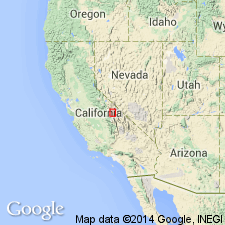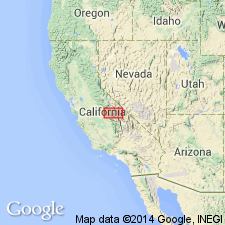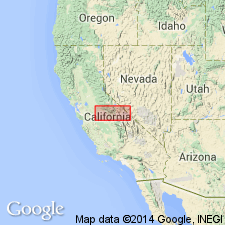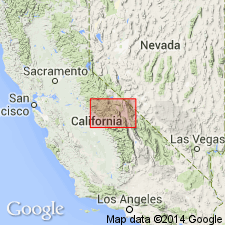
- Usage in publication:
-
- Wheeler Crest quartz monzonite*
- Modifications:
-
- Named
- Dominant lithology:
-
- Quartz monzonite
- AAPG geologic province:
-
- Sierra Nevada province
Summary:
Named after Wheeler Crest, east-central Sierra Nevada near Bishop. Type locality: northern side of Pine Creek Canyon [37 deg 24'N, 118 deg 39'W, Mount Tom 15' quad, Inyo Co, CA]. Called quartz monzonite of Wheeler Crest (Rinehart and Ross 1957). Well exposed in steep eastern face of Wheeler Crest where underlies more than 17 sq mi. Contains conspicuous phenocrysts of K feldspar, set in medium-grained, hypidiomorphic-granular groundmass. Intruded by Round Valley Peak Granodiorite, Tungsten Hills Quartz Monzonite (both new) and alaskite similar to Cathedral Peak Granite. Intrudes only diorite, quartz diorite, and hornblende gabbro. Is Cretaceous age.
Source: GNU records (USGS DDS-6; Menlo GNULEX).

- Usage in publication:
-
- Wheeler Crest Quartz Monzonite*
- Modifications:
-
- Geochronologic dating
- AAPG geologic province:
-
- Sierra Nevada province
Summary:
Samples 22-24 (location shown on map) of Wheeler Crest Quartz Monzonite yielded K-Ar ages on biotite and hornblende of 99 to 69 Ma.
Source: GNU records (USGS DDS-6; Menlo GNULEX).

- Usage in publication:
-
- Wheeler Crest Quartz Monzonite*
- Modifications:
-
- Geochronologic dating
- Age modified
- AAPG geologic province:
-
- Sierra Nevada province
Summary:
Included in Scheelite granitoid sequence. Sample 53 (location shown on map) of Wheeler Crest Quartz Monzonite gave 207.6 to 189.5 Ma on Pb-U-Th isotope ratios. Age changed from Cretaceous to Triassic.
Source: GNU records (USGS DDS-6; Menlo GNULEX).

- Usage in publication:
-
- Wheeler Crest Granodiorite*
- Modifications:
-
- Redescribed
- Revised
- Age modified
- Dominant lithology:
-
- Granodiorite
- AAPG geologic province:
-
- Sierra Nevada province
Summary:
Included as oldest unit in Scheelite Intrusive Suite (new). Name changed from Wheeler Crest Quartz Monzonite (Bateman, 1961) to Wheeler Crest Granodiorite because modal plots show median composition to be granodiorite. Rocks just east of Sierra Nevada were informally called quartz monzonite of Wheeler Crest (Rinehart and Ross, 1957); those farther eastward in Benton Range were called granodiorite of Benton Range (Rinehart and Ross, 1957; Krauskopf and Bateman, 1977). The name Wheeler Crest Granodiorite is applied to all these rocks. Typical rock is medium grained and megacrystic; lacks foliation in most places. Intrudes metamorphic rocks and small bodies of diorite and gabbro. Intruded by Tungsten Hills Granite. Younger K-Ar ages are thought to be reset during intrusion of nearby John Muir Intrusive Suite. Optimum U-Pb age of 210 (Stern, 1981) is Late Triassic.
Source: GNU records (USGS DDS-6; Menlo GNULEX).
For more information, please contact Nancy Stamm, Geologic Names Committee Secretary.
Asterisk (*) indicates published by U.S. Geological Survey authors.
"No current usage" (†) implies that a name has been abandoned or has fallen into disuse. Former usage and, if known, replacement name given in parentheses ( ).
Slash (/) indicates name conflicts with nomenclatural guidelines (CSN, 1933; ACSN, 1961, 1970; NACSN, 1983, 2005, 2021). May be explained within brackets ([ ]).

